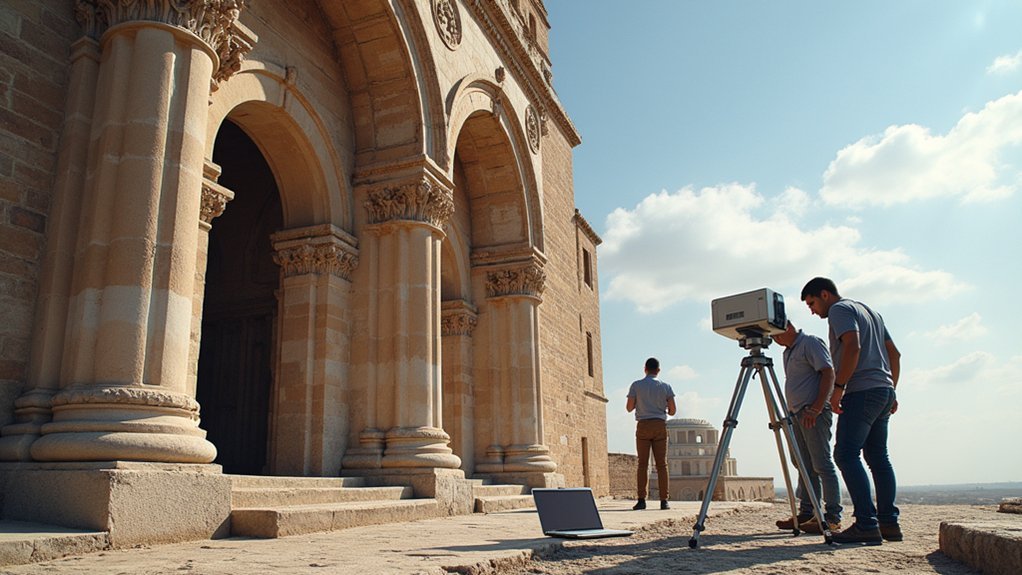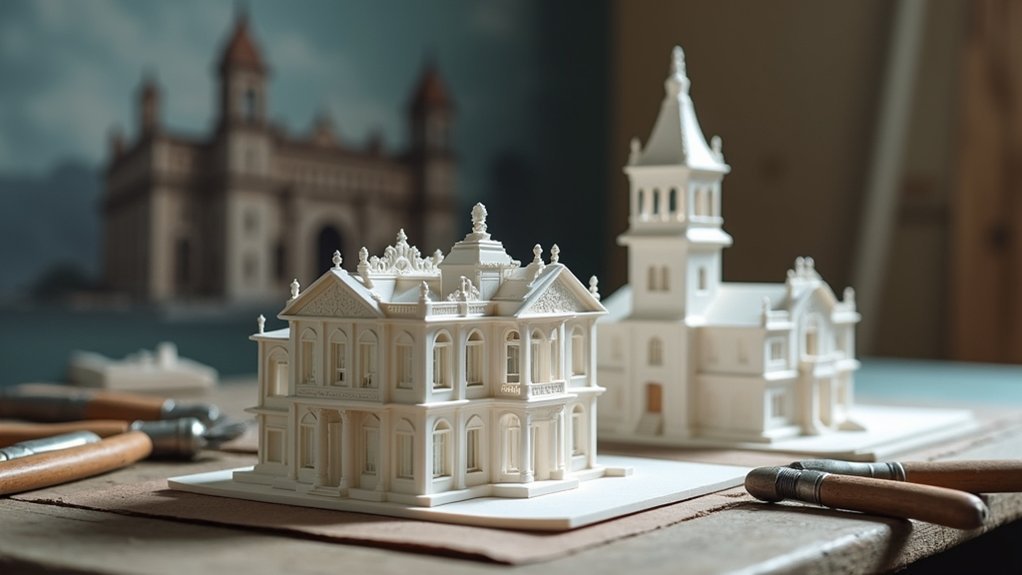You’ll preserve architectural heritage effectively by first capturing thorough 3D scans using advanced laser technology to document intricate details before restoration begins. Select materials that match your building’s original properties, incorporating resin-based composites and moisture-resistant options for authentic results. Collaborate with conservation experts and local communities to guarantee cultural accuracy and adherence to preservation standards. Document the historical significance and cultural context extensively, then establish robust digital archiving systems with multiple backups and detailed metadata. These foundational steps open up deeper preservation possibilities.
Capture Comprehensive 3D Scans Before Restoration Begins

Before you begin any restoration work, capture detailed 3D scans of the entire architectural structure to create an invaluable digital blueprint of its original condition.
Advanced scanning technologies like the KSCAN 3D laser scanner deliver precise measurements of architectural heritage, documenting intricate details and textures that traditional methods can’t match.
Modern 3D laser scanning captures architectural heritage with unmatched precision, preserving intricate details that conventional documentation methods simply cannot achieve.
These thorough digital records become essential resources for current and future restoration projects.
You’ll transform scan data into accurate 3D models and CAD models, enabling precise planning and execution.
High-resolution scans reveal structural integrity issues invisible during physical inspections, helping you identify problems before they compromise preservation efforts.
These digital archives serve as permanent documentation of historical buildings, ensuring their architectural details remain accessible for conservators and architects working on restoration projects decades from now.
Select Materials That Match Original Building Properties
When restoring architectural heritage, you’ll need to select materials that precisely match the original building’s physical properties to maintain both structural integrity and historical authenticity.
Advanced resin-based composites can replicate traditional stone and wood textures while guaranteeing seamless aesthetic compatibility with existing structures.
For 3D printing in architectural restoration, you should prioritize materials offering superior thermal resistance and moisture resistance.
Modern additives enhance these properties without compromising visual appearance.
Consider using biodegradable materials to align with heritage preservation goals while protecting environmental integrity.
Collaborate with material scientists to develop custom 3D printing materials that reflect your heritage building’s unique characteristics.
This partnership guarantees ideal matching of original building materials, creating restoration solutions that preserve historical value while incorporating modern durability standards for long-term structural performance.
Collaborate With Conservation Experts and Local Communities

Beyond selecting the right materials, successful heritage preservation depends on building strong partnerships with conservation experts and local communities.
When you collaborate with conservation experts, you’ll guarantee adherence to preservation standards and compliance with established protocols, just like the Notre Dame Cathedral restoration project demonstrated.
Engaging local communities provides invaluable insights into the cultural significance of architectural sites, fostering ownership and stewardship. Their involvement enhances public engagement while promoting awareness of local history.
You’ll benefit from local artisans who contribute traditional techniques and knowledge that, when combined with 3D printing technology, create innovative solutions for culturally sensitive restoration efforts.
Establishing partnerships with cultural organizations and universities facilitates resource sharing and access to advanced technologies, maximizing your project’s success.
Document Cultural Context and Historical Significance
Three essential components form the foundation of any successful preservation project: understanding the building’s original purpose, identifying its architectural significance, and capturing the stories embedded within its walls.
You’ll need to research historical documents and gather local narratives to understand the cultural heritage surrounding your structure. Focus your documentation process on recording architectural details, original materials, and construction methods that define the historical architecture.
Community engagement enhances your understanding of the building’s cultural relevance while fostering local ownership.
Meaningful community involvement builds deeper connections to heritage sites while ensuring local voices shape preservation decisions.
When you document historical significance thoroughly, you’re creating invaluable records that’ll guide future restoration projects. This extensive analysis of architectural features guarantees your preservation efforts maintain the structure’s authentic character and historical integrity throughout any restoration work.
Ensure Long-Term Digital Archive Accessibility

Since digital preservation forms the backbone of modern heritage conservation, you’ll need to establish robust archiving systems that guarantee future generations can access your project’s documentation.
Your 3D printing initiatives for architectural heritage depend on creating thorough digital archives using standardized formats like STL or OBJ. These guarantee compatibility across platforms while scanning technology captures cultural artifacts with precision.
Implement these critical preservation strategies:
- Create multiple backup locations – Store your digital models in cloud storage and external drives to protect irreplaceable cultural heritage from catastrophic loss.
- Add detailed metadata tags – Enable researchers to discover specific architectural elements efficiently through descriptive information.
- Update storage infrastructure regularly – Adapt to technological advances guaranteeing long-term access to your precious digital archive.
Collaborate with preservation institutions to maintain accessibility standards.
Frequently Asked Questions
How Can 3D Printing Be Used in the Field of Cultural Heritage Preservation Such as for Creating Replicas of Historical Artifacts or Sites?
You can use 3D printing to create precise replicas of damaged artifacts, reconstruct destroyed monuments from digital models, and produce educational copies for museums while preserving original pieces safely.
What Is One Benefit of Using 3D Printing Over More Traditional Building Methods?
You’ll achieve much faster project completion with 3D printing since it can replicate complex architectural details in hours or days, while traditional methods often require weeks or months of painstaking manual work.
How Does 3D Printing Help Art Preservation?
You can create exact replicas of fragile artworks without touching originals, preventing damage during study. You’ll also produce backup copies that preserve cultural heritage if originals are lost or destroyed.
How Does 3D Printing Affect Architecture?
You’ll find 3D printing revolutionizes architecture by enabling rapid prototyping of complex designs, reducing construction costs, creating customized building components, and allowing architects to test innovative structures before full-scale implementation.





Leave a Reply